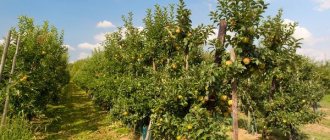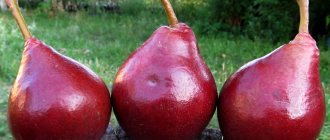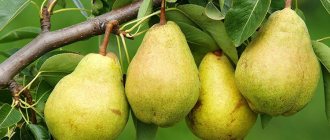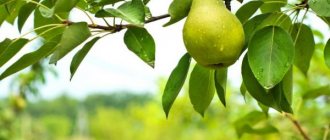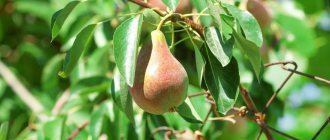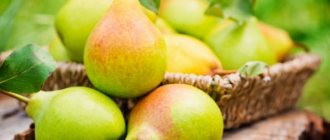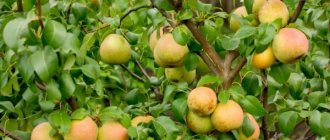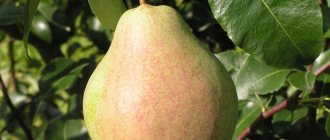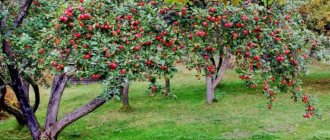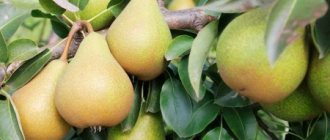The pear variety "Zaveya" is a great success among gardeners, although it is still very young. Having examined in detail its strengths and weaknesses, its cultivation features, you can understand why it is in demand in Russian markets.
Pear "Zaveya"
Zaveya: winter-hardy, high-yielding (up to 20 t/ha) variety
History of variety development
The pear variety “Zaveya” was bred in 2021 at the Belarusian Institute of Fruit Growing. Work on the variety took a little over a quarter of a century, and the resulting plant fully justifies the time and money spent on its creation.
The variety closest to the “Zaveya” pear is the “Simply Maria” variety, but it has one serious difference - it cannot withstand such low temperatures. This difference classifies “Zaveya” as a winter variety, while “Simply Maria” is an autumn variety.
Description of the tree and fruits
The height of the pear reaches a maximum of 4 meters, which makes the variety medium-sized. The crown is dense, pyramidal in shape, and during flowering it is covered with a layer of white flowers. Pear leaves have a dark green glossy color.
The fruits are medium in size - about 180 g, green in color and have a truncated conical shape. Gardeners note the high taste qualities of the pear and its aroma. The skin of the fruit is dry, smooth, thin. There are small greenish dots on the inside of the skin, which distinguishes this variety from many that are visually similar to it. The pulp is oily, juicy, white-green in color.
Pollination, fruiting, ripening period
This variety is self-sterile. To pollinate it, there must be a pollinator nearby the tree, the flowering period of which coincides with “Zaveya”. These varieties include “Bessemyanka”, “Yakovleva’s Lyubimitsa” and some other varieties.
The pear begins to bear fruit 3-4 years after planting in the ground. The marketable fruit yield is 93%, which is a fairly high figure for fruit and berry plants.
The “Zaveya” pear can itself regulate the optimal number of fruits on the tree, dropping the excess ones, due to which the remaining fruits receive enough nutrients and grow large and with few flaws.
The average harvest time is mid-autumn, by which time the fruits acquire a yellow-green hue.
Pear Zaveya: variety description, reviews and photos
Pear is a southern fruit whose taste has been known since childhood. Thanks to the work of breeders, the fruit crop can now be found in cities with a warm and unstable climate. Zaveya pear is a new unpretentious variety that has gained great popularity among gardeners. Strengths and weaknesses, growing features, description of the Zaveya pear will allow you to understand why the variety is in demand among summer residents.
Description of the pear variety Zaveya
The Zaveya pear was bred by Belarusian scientists in 2021 by crossing the Bere gray, Dulya Ostzeyskaya and Oil Rose varieties. Zaveya is a winter, high-yielding variety that can withstand temperatures down to -30 °C without shelter.
The plant is medium-sized, grows up to 4 m in height. The Zaveya pear forms a pyramidal, sparse crown formed by light brown shoots.
The curved branches bear dark emerald, glossy leaves of small size. In spring, during the flowering period, the crown is covered with numerous snow-white flowers.
For abundant fruiting, the Zavea pear requires pollinating varieties that bloom at the same time.
Characteristics of pear fruits
The delicate green fruits of the Zaveya pear are truncated in shape and weighing 180 g and have juicy, aromatic pulp. The skin is thin but dense, due to which the crop is stored for a long time and can withstand long-term transportation. When properly stored, fruit retains its freshness and taste for 6 months.
Optimal growing conditions
For good development and generous fruiting, you need to know where the pear tree likes to grow. The Zaveya pear prefers to grow on slightly acidic, fertile, light soil with a groundwater depth of at least 2 m.
A bright place, protected from drafts, is suitable for planting seedlings. Since the tree is medium-sized and does not like shading, the planting area must have sufficient area.
Planting and caring for the Zaveya pear
The area for planting pears is prepared in the fall. To do this, dig up the soil and apply organic and mineral fertilizers:
- when grown on loam when digging per 1 sq. m add 60 g of superphosphate, 6 kg of rotted compost or manure, 15 g of potassium;
- Humus and clay are added to sandy soil.
Advice! The Zaveya pear will not grow on clay soil, even if it is improved and fertilized.
Before planting, you need to choose the right seedling. It is purchased from trusted suppliers, gardeners or nurseries. A healthy young plant should have well-developed roots and a healthy trunk without mechanical damage or signs of disease.
It is better to purchase Zavea pear seedlings when they are 1-2 years old. A young plant should have lateral branches from 12 to 30 cm long. They should be elastic, without growths and signs of disease. It is better to purchase seedlings with a closed root system, but if the roots are open, they are wrapped in a damp cloth during transportation.
Before planting, the root system of the pear is cut by 10 cm and kept in warm water for about 6 hours.
Watering and fertilizing
An adult pear tree forms a powerful root system, so watering is carried out as the top layer of soil dries out. The young tree is watered weekly with 20 liters per specimen.
The main rule of watering is to provide the tree with a large amount of water during the period of fruit formation and after leaf fall, when the plant is preparing for wintering. Watering is carried out in specially dug trenches around the trunk, 2 cm deep.
After irrigation, the ditch is filled with nutrient soil and mulched.
If a young pear is planted in nutritious soil, it is not fed in the first year. Next, fertilize several times a season:
- in spring - nitrogenous fertilizers or organic matter;
- during the flowering and fruiting period, fertilize with nitroammophoska;
- after harvesting - phosphorus-potassium fertilizers.
Also, in early spring, before the buds open, foliar feeding is carried out. The tree is sprayed with a solution: 0.5 kg of urea is diluted in 10 liters of warm water.
Complex mineral fertilizers are applied annually, but organic matter should be applied no more than once every 3 years.
Important! Fresh manure is not suitable for feeding, as it can have a detrimental effect on the plant.
To obtain a stable harvest, it is necessary to carry out annual formative, sanitary and rejuvenating pruning.
Important! If you do not prune, the garden pear will quickly go wild and stop producing large, tasty fruits.
The crown of the Zaveya pear is formed over the course of 6 years.
- 1st year - the lower branches are removed, the height of the trunk should be 40-50 cm from the ground. At a height of 90 cm from the headquarters, 3 branches are left on each side. They must be the same length, the excess ones are removed. The conductor is shortened by 1/3 of the length.
- 2nd year - remove growths that appear between the skeletal branches. The shoots that grew after the lower tier are shortened.
- 3rd year - form the 2nd tier. To do this, in the spring, before the buds on the upper stem branch of the lower tier swell, all growths to a height of 45 cm are removed under the ring. The branches of the second tier should be located between the spaces of the lower tier at a height of 25 cm so that they do not shade each other. The main shoots are shortened by 1/3 of the length, and the conductor is shortened by 20 cm.
- 4th year - the conductor is shortened to a side shoot to stop growth in height. The tree is pruned at a height of 50 cm from the trunk branch of the 2nd tier. All branches are cut to 1/3 of the length, and the growths between the tiers are removed under the ring.
- 5th year - the height of the Zaveya pear reaches 3.5-4 m. In order for the tree to stop growing, the conductor is cut off above the upper skeletal branch. In the formed crown, the 2nd order stem branches should be located 90 cm from the conductor and 0.5 m from each other.
Important! When pruning, it is necessary to take into account that the branches of the 2nd tier should be shorter than the branches of the 1st tier.
Sanitary pruning of pears of the Zaveya variety is carried out in early spring before sap flow and in autumn, after leaf fall. To do this, remove damaged, dry branches, as well as those growing upward and at an acute angle to the trunk. Pruning is carried out strictly under the ring, since leaving a stump can contribute to the spread of rot.
Rejuvenating pruning is carried out if the tree has stopped producing large fruits. To do this, in the fall, a month before the onset of frost, the branches are cut to 40 cm in length.
Pruning allows dormant buds to wake up and form new branches. It is also necessary to shorten the conductor on the side branch.
This procedure will allow the tree to redistribute nutrients, renew the crown, resume fruiting and the quality of the harvest.
Whitewash
Whitewashing will protect the bark from the winter and spring sun. To do this, use lime diluted in warm water to form a thick kefir. To protect the plant, the trunk and eyelids of the lower tier are treated.
Preparing for winter
From the description it is clear that the Zaveya pear is a frost-resistant variety, so the adult plant does not need shelter. To prepare a tree for winter, it is watered generously, fertilized with phosphorus-potassium fertilizers, and the soil around the perimeter of the tree trunk is mulched with straw, pine cones, fallen leaves or sawdust.
A young plant, regardless of cold resistance, must be protected from frost. To do this, the tree trunk is tied with coniferous spruce branches.
Pollination
The Zaveya pear is a self-sterile variety, so it needs pollinators for a bountiful harvest. These varieties include: Bessemyanka and Lyubimitsa Yakovleva.
Fruiting of the variety occurs 4 years after planting. The Zaveya pear has one peculiarity: it itself controls the optimal number of fruits. When there is a lack of nutrients, it begins to discard excess crops. The fruits remaining on the tree grow large, juicy with few flaws.
Breeding history
The Institute of Fruit Growing in Belarus is considered one of the most powerful breeding departments in Eastern Europe. In recent years, they have managed to develop more than 20 new varieties of pears, which have perfectly complemented the collection of fruit crops in this country.
This included the “Zaveya” variety, work on which took about 26 years.
The closest relative of “Zaveya” is the “Simply Maria” variety, which belongs to the autumn pear, while the described variety is a winter one.
Breeders tried to create a variety that could withstand frost down to -30 ° C and have high taste. This is exactly what the “Zaveya” pear became.
Description of the tree
The tree of the “Zaveya” variety is medium-sized, and its maximum height reaches 4 m. The crown is pyramidal in shape and not very dense. The tree is deciduous: small leaves may have a dark green, glossy color. During the flowering period, the pear comes to life, and white flowers completely fill the sparse crown.
Description of fruits
It is important to note the characteristics of the fruits of this plant. The fact is that in addition to a pleasant aroma and high taste, they have decent dimensions, on average 180 g.
The shape of pears is truncated-conical, and the predominant color is green. Quite often, depending on the climatic conditions of the tree’s development, there is a diffuse pink blush that covers the fruit. The skin is dry and shiny, smooth and thin. A distinctive mark of the fetus is the presence of small greenish subcutaneous dots.
Fruiting
Fruiting of the “Zaveya” variety occurs in the first 3-4 years after planting in the garden. The yield of marketable fruits is an important indicator for pears, it is 93%, and the profitability level reaches 92.5%.
Maturation period
They are harvested in mid-autumn, when the pears become yellowish in color and fill with juice. The tree is able to independently shed excess ovary, as a result of which the fruits are very large and aligned.
Transportability and storage
It is important to note that the harvest should be unripe, since the fruits of the tree ripen well in storage. It is better to store the harvest in a cool, dark place, where it will ripen and its fruits will turn golden with juicy pulp.
Thus, a long-term harvest can be stored for 6 months without losing its taste.
The variety is characterized by good transportability of fruits.
Resistance to environmental conditions and diseases
The “Zaveya” variety is highly resistant to climatic conditions and various diseases.
However, in the absence of proper care and prevention of diseases such as scab or moniliosis, the tree may become ill. Scab harms many garden crops.
Recognizing this disease will not be difficult, since olive spots with a velvety coating appear on the surface of the foliage.
Soon they move on to the fruits, which become covered with putrefactive spots. This plaque consists of an accumulation of spores of a parasitic fungus. The best prevention against scab is good air circulation and ventilation.
The crown of the tree needs thinning, and the soil around the trunk —
in loosening. Falls should be cleaned regularly and fallen leaves should be burned. If the tree is heavily infected, you need to treat it with Nitrafen paste.
Another disease is moniliosis. In this case, the fruit completely rots, as a result of which it turns brown with white growths.
Some of these fruits fall off, and the rest remain to rot right on the branches, which is a prerequisite for the development of this disease next year.
Prevention includes: pruning branches that have been mechanically damaged, regularly picking fruits and eradicating infected fruits.
pros
Among the advantages of this variety, the most significant are:
- high and stable yield;
- large fruit sizes;
- excellent taste and aroma;
- excellent winter hardiness;
- long shelf life (up to 6 months);
- undemanding climate;
- resistance to diseases.
Minuses
As such, there are no obvious disadvantages to the Zaveya pear, but there are still disadvantages:
- exposed to diseases of serious parasitic fungi;
- does not tolerate clay soil well;
- like all pears, it does not tolerate excess water.
Thus, the “Zaveya” pear is an excellent modern variety that was released in 2021 and has already established itself as a reliable and high-quality product. Until today, it has not gained much popularity, since not many gardeners accept innovations in breeding work, while remaining faithful to varieties that are average in quality and productivity.
But “Zaveya” has already penetrated into domestic markets and fully justifies the trust of consumers.
Features of planting pear "Zaveya"
Pears, like most trees, have their own planting characteristics. By observing planting conditions and gradually preparing the soil and tree, you can get a good harvest in the shortest possible time.
Conditions
To plant “Zaveya” pears, use soil that allows moisture and air to pass through well. Also, the soil should contain a little clay - this will allow moisture to be retained at the roots, and this is important for the characteristics of the tree’s root system. The landing site should be open to the sun; the presence of constant water vapor in the air is undesirable.
The optimal time for planting pears is autumn. Sometimes a tree is planted in the spring, having previously prepared planting holes in the fall.
Planting stages
There are several stages of planting a pear. The landing proceeds as follows:
- Prepare the top fertile layer of soil removed from the hole. This layer is mixed with organic and mineral fertilizers. After mixing, it is poured back into the pit.
- Soil is poured into the center of the hole in a mound and a stake is placed there. The tree is placed in a hole, spreading its roots over the hill. The root collar should be located 3 cm above ground level. The roots are covered with earth and compacted.
- The circle near the trunk is laid with earth in the form of a roller and watered; 2 buckets of water will be enough. After water is absorbed, the ground around the tree is mulched, and the tree itself is tied to a stake.
You cannot use fresh manure for placing in the planting hole - it can subsequently damage the root system.
Zaveya pear: description and characteristics of the variety, advantages and disadvantages, cultivation
Zaveya pear is a Belarusian variety that is gaining popularity among gardeners. It is distinguished by late ripening, keeping quality and high harvest quality. The Zaveya variety was bred at the famous Belsad Institute of Fruit Growing. During selection, emphasis was placed on frost resistance and taste of the fruit.
Description of Zaveya pear
The Zaveya pear was obtained in 1990. The parent varieties are the Ukrainian hybrid Maslyanaya Ro and the Belarusian seedling 6-89/100. The name of the resulting pear is translated as “blizzard” or “blizzard”.
This is a medium-sized tree with a wide pyramidal crown. It reaches a height of 4 m. Its shoots are located at right angles to the trunk. The degree of thickening is medium. Fruiting occurs on complex and simple ringlets.
The leaves of the plant are wide, ovoid, up to 10 cm long. The leaf blade is pointed at the tip. Its color is dark green, turning yellow-orange in autumn. The flowers of the crop are white, up to 3 cm in size, collected in brushes, consist of 5 petals.
The Zaveya variety is successfully grown in Russia. It is recommended to plant it in the middle zone and southern regions. In colder climates, the late variety does not have time to ripen. Due to early flowering, the ovaries may suffer from spring frosts.
According to the photo and description of the variety, the fruits of the Zaveya pear have the following characteristics:
- medium and large sizes;
- weight about 160 g, maximum – 300 g;
- standard pear shape;
- green-yellow color;
- slight rustiness;
- subcutaneous dots are small, green;
- there is no blush, sometimes it appears as a pale pink spot;
- the skin is medium thick, dry, rough.
The pulp of the Zaveya variety is white, with a yellowish tint, tender, juicy, semi-oily. The pear is fine-grained, medium-density. All fruits are one-dimensional, aligned in shape. Their taste is sweet, dessert, the originator assigned it a rating of 4.8 points.
Characteristics of the Zaveya pear variety
Before choosing a Zaveya pear, evaluate its main characteristics. For gardeners, what matters is the crop’s resistance to drought and frost, its self-fertility, yield and fruiting time.
Drought resistance, frost resistance
The Zaveya variety has average resistance to drought. During the growing season, the tree is watered to ensure the formation of ovaries and fruit filling. Pear has high frost resistance for Belarus and central Russia.
Pollinators
The Zavea pear is self-sterile. To obtain a high yield, at least one pollinator is required. Select varieties that have the same flowering periods. Pollination of the variety occurs with the participation of bees, butterflies and other insects.
In Belarus, the flowering of the Zaveya variety begins in the first ten days of May. Depending on weather conditions, these dates may shift. The flowering period of the tree lasts from 8 to 12 days.
The best pollinators are the Kupala and Prosto Maria varieties. These are winter-hardy hybrids of Belarusian selection. All of them bear fruit late in the season – in late summer or autumn. The Zaveya pear is also used as a pollinator for the varieties Veles, Belorusskaya late, Kudesnitsa, and Pamyati Yakovleva.
Advice! The optimal distance between pollinating varieties is 5 m.
Productivity
For planting, annual seedlings of the Zaveya variety are used on a seed rootstock. The tree quickly begins to bear fruit. The harvest is harvested already in the 3rd year after planting. The fruits are harvested at the stage of technical maturity, which occurs in early autumn.
At the age of 5 years, the Zaveya pear bears about 20 kg of fruit. 95% of the harvest has excellent commercial quality. The fruiting of the crop is assessed as stable from year to year. Productivity is positively influenced by soil fertility, moisture supply, fertilizing, and tree formation.
Application area
The fruits of the Zaveya variety are universally used. They are used fresh, prepared with fruit salads, combined with yoghurts and other products. Regular consumption of pears improves immunity, reduces cholesterol levels, and improves metabolism. A variety of homemade preparations are obtained from the fruits: compotes, jam, jam, juices.
After harvesting, the crop is stored in a cool place. The fruits tolerate transportation well. The period of consumer maturity begins in November-December. The shelf life of the Zaveya variety is until February of next year.
Advantages and disadvantages
Advantages of growing Zaveya pear:
- good fruit quality;
- long period of crop storage;
- precociousness;
- regular fruiting;
- resistance to diseases.
Disadvantages of the Zaveya variety:
- in cold climates the fruits do not have time to ripen;
- pollinator required.
Landing rules
Pears are planted at certain times when sap flow in the trees is slow. They find a good place for the culture where it will receive enough heat and light. The work is carried out sequentially, starting with preparing the soil and ending with caring for the seedling.
Recommended timing
Zaveya pear is planted in the fall, in October or November. The latest planting date is 3 weeks before the onset of cold weather. During this period, the seedling will have time to adapt to new conditions. It is allowed to postpone planting to spring. Then the work is carried out after the snow has melted, when the soil has warmed up well, but the leaves have not yet blossomed.
Site selection and soil preparation
A sunny place located on a hill or a slight slope is suitable for a pear. In this case, choose a site on the western or southern side.
The culture prefers fertile soil: gray forest or black soil. If the soil is clay or sandy, then its composition needs to be improved. In the first case, coarse river sand and humus are added.
The properties of light soil are improved with clay and compost.
The Zaveya pear is planted in a prepared hole. To fill it, a substrate is required: 30 kg of compote or rotted manure, 1 kg of superphosphate, 200 g of potassium salt, fertile soil. The components are thoroughly mixed.
Selection and preparation of seedlings
A plant aged 1 or 2 years is suitable for planting. It is inspected first: there should be no traces of rotting, soft areas, growths, cracks, or deformed areas on the roots and shoots.
Important! Before planting, the pear roots are immersed in clean water for 12 hours.
Landing algorithm
Regardless of the planting time, the order of work remains the same:
- A hole measuring 70x70 cm is dug on the site. Its depth is up to 1 m.
- If the soil is dense, a layer of expanded clay or broken brick 15 cm thick is poured onto the bottom.
- Then pour in half the substrate, compact it and pour out a bucket of water.
- The pit is left for 2 - 3 weeks for shrinkage.
- A support made of wood or metal is driven into the middle of the pit.
- The remaining substrate is transferred into the pit and a mound is formed from it.
- The seedling is placed on the top, its roots are covered with fertile soil.
- The plant is watered abundantly.
- Humus or peat is poured into the tree trunk circle for mulching.
Aftercare
The pear is watered twice during the season: during the flowering period and during the formation of the ovaries. Moisture helps the fruit gain weight. Depending on the age of the tree, 2 - 4 buckets of water are poured into the circle around the trunk. The older the plant, the more intense the watering.
During the season, the Zaveya variety is fed 3-4 times. In early spring, ammonium nitrate is added to the soil in the form of a solution. To do this, take 40 g of the substance per 10 liters of water. In July, the Zaveya variety is fed with phosphorus-potassium compounds.
The tree is pruned annually in spring or autumn, when sap flow is slow. When pruning, healthy and strong shoots are left that will bear fruit. Dry or frozen branches are completely cut off.
In the fall, Zaveya pears begin to prepare for winter. The tree trunk circle is cleared of fallen leaves. Pests and pathogens often overwinter in them. The trunk is covered with earth, and an additional layer of peat or humus is added.
Important! To prevent rodents from damaging the pear, install a protective net or wrap the lower part of the tree with roofing material.
Pests and diseases
The Zaveya variety is resistant to major diseases: scab, bacterial canker, septoria, rust. If agricultural practices are followed, the tree does not suffer from diseases and pests. If there are lesions, the pear is treated with special preparations.
Conclusion
The Zaveya pear is suitable for growing in Belarus and central Russia. The variety is valued for its late ripening, good fruit taste and long shelf life. When growing pears, pay attention to watering and fertilizing. The crown is trimmed regularly and preparations are made for wintering in the fall.
Reviews of Zaveya pear
Markina Lyudmila Ivanovna, 38 years old, KurskGrusha Zaveya is a wonderful winter variety. The tree is large, with a spreading crown. The first harvest was obtained in the 3rd year after planting. Pear fruits are greenish, with subtle pink spots. They are not very large, but sweet and juicy. The harvest lasts until December without any problems. The variety turned out to be winter-hardy and never got sick during the entire growing period. Even when signs of scab appeared on other pears, spots did not appear on the leaves of Zaveya. Petukhov Maxim Petrovich, 58 years old, Orekhovo-Zuevo I grow different varieties of pears on my plot in the Moscow region. In our climate it is not easy to get sweet fruits. However, the Zaveya variety pleasantly surprised me. The pear is quite large, its flesh is juicy and fine-grained. In general, its taste is harmonious, sweet and sour, quite rich. In a hotter climate, the taste will certainly improve. The fruits are ready for consumption by mid-November. In the future, their taste does not improve in any way. I first store the harvested crop at home, then transfer it to the cellar.
Source: https://AgroGnom.ru/fruits/pear/grusha-zaveya-opisanie-foto-otzyvy-posadka-i-uhod.html
Care and cultivation
The most unprotected place in a pear tree is the roots - in winter they can be damaged, so it is important to insulate them well. To insulate the roots of young trees, film, straw, paper or sunflower leaves are often used; in winter, the roots of mature trees can be covered with more snow.
The area around the pear tree trunks should always be cleared of weeds.
The main stages of caring for a pear tree include:
- hilling;
- mulching;
- watering;
- pruning;
- fertilizer.
The first two stages are standard, the last three stages have their own characteristics.
Watering
The optimal watering system for pears is sprinkling. A sprayer with many small holes is perfect for this; it doesn’t matter whether it stands still or spins. In the absence of such a sprayer, make a ditch around the tree trunk circle, 10-20 cm wide, and pour water into it. It is enough to water the pear this way several times in the spring and summer; in particularly dry weather, water it more often.
For 1 sq. m of tree trunk circle you need 3 buckets of water. To provide the roots with oxygen, the soil is loosened after watering.
Trimming
Pruning branches is a necessary measure that allows, over time, to achieve an optimally formed tree crown, without unnecessary shoots and unproductive branches.
For planting, two-year-old pear seedlings are usually used. By this time, the tree already has about 8 lateral branches - of which half of the branches, equidistant from each other and extending from the trunk at an angle of 45°, are chosen to be skeletal. When planting annual seedlings, they are shortened to half a meter in height.
For good branching of a tree, its branches are shortened at the same height by a quarter, while the conductor is left higher, about 25 cm.
When the crown has already formed, only the branches growing inward and broken are cut off.
Pear fertilizer
The application of fertilizers and their quantity is always based on the condition of the tree and its characteristics. The growth of shoots of 40 cm in a young tree and half the growth in an adult is an unambiguous indicator of the pear’s need for fertilizer.
Fertilizers are applied after the first year of pear life; the optimal time for this is spring and autumn; in the summer, small fertilizing is sufficient for the tree.
Mineral additives are used for annual fertilization; organic fertilizers are applied once every three years. A trench is dug around the tree, the length of which depends on the volume of additives. For 1 sq. m of the trunk circle is taken:
- humus – 10 kg;
- potassium chloride – 25 g;
- urea – 15 g.
Fertilizers are poured into such a trench along with the soil - this option is better than applying fertilizers during digging, because the evaporation of mineral and organic substances important for the tree occurs more slowly than from open ground.
To maintain high yields, the tree is also treated with lime milk every year, where 100 g of lime is taken per 1 liter of water.
Aftercare
The pear is watered twice during the season: during the flowering period and during the formation of the ovaries. Moisture helps the fruit gain weight. Depending on the age of the tree, 2 - 4 buckets of water are poured into the circle around the trunk. The older the plant, the more intense the watering.
During the season, the Zaveya variety is fed 3-4 times. In early spring, ammonium nitrate is added to the soil in the form of a solution. To do this, take 40 g of the substance per 10 liters of water. In July, the Zaveya variety is fed with phosphorus-potassium compounds.
The tree is pruned annually in spring or autumn, when sap flow is slow. When pruning, healthy and strong shoots are left that will bear fruit. Dry or frozen branches are completely cut off.
In the fall, Zaveya pears begin to prepare for winter. The tree trunk circle is cleared of fallen leaves. Pests and pathogens often overwinter in them. The trunk is covered with earth, and an additional layer of peat or humus is added.
Important! To prevent rodents from damaging the pear, install a protective net or wrap the lower part of the tree with roofing material.
Tree diseases and their control
The variety "Zaveya" has good resistance to various diseases. The table below shows the most common pear diseases.
Table 1 – Common diseases of the “Zaveya” pear variety
| Pear diseases | Features of the disease | Methods of control and prevention |
| Scab | The peak incidence occurs in early spring. It is characterized by the appearance of a brown-green coating on the leaves followed by their falling off. | Ensuring sufficient air circulation around the tree, which includes ventilation and spraying. Also, for prevention, the crown is thinned out and old branches are removed. |
| Powdery mildew | It affects not only leaves, but also buds, shoots, and inflorescences. First, a dirty white coating forms on them, then its color changes to brown and black dots appear. | Destruction of affected areas of the tree, deep fall plowing. For prevention, phosphorus-potassium fertilizers are applied. |
| Sooty fungus | The leaves and fruits of the pear are covered with a black coating. | Reducing the number of insect pests. Providing the tree with sufficient levels of humidity and air circulation. |
| Fruit rot | It is transmitted by airborne droplets, which endangers all trees in the vicinity of the infected one. It affects the fruits of the tree, leaving brown-gray circles of rot on them. | Spraying the entire tree with Bordeaux mixture. All affected fruits and branches are first removed. |
| Rust | It affects the leaves - a rust-like coating appears on them on the outside. | Planting bushes with a dense crown around an area. Use of mineral fertilizers. |
This variety is especially susceptible to fruit rot and scab, so these two diseases are a priority in prevention.
Diseases and pests
This type of pear is characterized as disease resistant, but if not properly cared for it can be susceptible to scab and moniliosis. The scab first destroys the leaves, forming velvety olive-colored spots, and then spreads to the fruits. The best prevention against spores of such a fungus is spraying, ventilation and ensuring constant air circulation.
In addition, to protect the tree from scab, it is worth periodically removing old branches and thinning out the crown.
Moniliosis is the rotting of fruits, as a result of which half of them fall off, and the other half remains to rot on the tree. This problem may recur from year to year. Bad fruits should be removed immediately, completely affected branches should be cut down, and the tree should be sprayed with Bordeaux mixture.
Collection, storage and transportability
An important point when harvesting this pear will be time - due to its ability to ripen well during storage, the fruits are harvested unripe.
Store the harvested crop in a cool place without access to direct sunlight. Over time, the color of the fruit will change to green-gold, and the pulp will acquire a full-fledged taste.
The fruits of the Zaveya pear can retain their taste for up to six months if properly stored.
During storage and transportation, the fruits keep their shape well, which gives them additional advantages during marketing.
Pros and cons of the variety "Zaveya"
After a detailed examination of the “Zaveya” variety, it is easy to identify several of its main advantages and disadvantages.
Benefits include:
- high productivity;
- resistance to low temperatures;
- prostate acclimatization;
- high quality indicators of fruits;
- ease of storage and transportation.
There are very few disadvantages, among them are:
- demanding control of watering;
- susceptibility to certain diseases.
We recommend reading an article that will tell you about the other most popular varieties of pears.
Thus, the still very young pear variety “Zaveya” can already be called an excellent, high-quality and reliable product. In terms of taste and quality characteristics, it is not inferior to most long-bred varieties, and some of them are superior in many ways. It is quite clear why it is rapidly gaining popularity among gardeners.
0
0
Copy link
Reviews of Zaveya pear
Ilyushin Igor Bogdanovich, 60 years old, Brest
I have been planting pears for a long time. Early and late varieties grow in the garden. Among the late-ripening varieties, I highlight the Zaveya pear, since the variety is unpretentious, does not require shelter for the winter, and produces a stable, generous harvest of tasty and aromatic fruits. Despite the thin peel, the fruits are stored for a long time and are well transported over long distances.
Alekseeva Alevtina Pavlovna, 65 years old, Smolensk
Pear is a favorite fruit crop. I used to think that it could only be grown in regions with a warm climate, but recently I began to notice pear trees in neighboring gardens. I looked through the information on the Internet and chose the Zaveya pear variety. I planted it and was not disappointed. The first harvest was small, but the next year I collected up to 10 kg of fruit. The main rule for a generous harvest is compliance with the rules of planting and care, as well as timely pruning.
